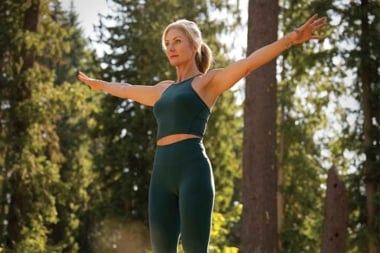
It doesn't matter what your weight class is, a boxing workout is a great way to get fit.
Tough. Bloody. Hyper-Masculine. If this is your perception of boxing, you may want to reconsider.
A growing number of fitness enthusiasts are embracing boxing as a workout that burns calories; boosts agility, balance, and coordination; and builds community, delivering the sport’s negative reputation a one-two punch.
Like many, Kathleen Sharpe had a negative opinion of boxing.
“It always seemed like such a male sport, one that can be brutal,” recalls Sharpe, 62, director of a Toronto nonprofit organization.
A new friendship with a female boxer—and seeing a boxing class that looked fun, yet tough—led Sharpe into the sport. She boxes once a week as part of her workout regimen and credits the sport for helping her build muscle and sustaining a 30-pound (14 kg) weight loss for 10 years.
“For me, working out, training, and boxing are all about mental and physical health, aging well, staying strong, and looking great,” says Sharpe.
Boxing benefits
Weight loss and toning
Teddy Castela, owner and coach at Vancouver’s Powercore Boxing and Fitness, witnesses boxing’s impact on weight loss and muscle tone on a regular basis: one of his clients lost 40 pounds (18 kg) through fight preparation, thanks to the 350 to 450 calories boxing torches in a single workout. This whole-body workout also sustains a heart rate at 75 to 85 percent of maximum.
“Everybody associates boxing with hands, arms, and upper body, but the punches come from the legs and the rotation—there’s a big core element to it,” explains Castela.
Agility and balance
In the ring, boxers bob and weave out of their opponent’s reach. These intricate evasion tactics require balance and agility. To advance these skills, coaches use exercises including balance boards, agility ladders, skipping, and footwork drills.
A 2010 study found another application: after Parkinson’s patients experienced a 12-week boxing program, they saw improvements in balance and gait.
Hand-eye coordination
Boxers must also become adept at hitting a moving target, so coaches like Castela help boxers develop their hand-eye coordination, primarily through mitt work (a small target held by a partner used to practise punching combinations, mimicking the action in the ring).
“Once you get sparring, it’s very similar to hitting the mitts,” says Castela.
Community connection
At Clancy’s Boxing Academy in Toronto, managing director Kristina Ejem has seen boxers connect—in her women’s program especially—over the shared experience of learning a fun, new sport, building friendships while improving their skills. The more experienced women often guide beginners, says Ejem.
Bonding also happens in the ring.
For 12 weeks, in Ejem’s corporate program, employees train under seasoned instructors, culminating in a fight night for charity where colleagues and friends cheer on the contenders.
The unique experience catalyzes lifelong friendships, says Ejem.
“You’re bonded with these people for life because no one else can understand getting punched in the face every other day,” says Ejem.
Interested in boxing but not sure where to start?
Boxing class at a fitness club
Some trainers, like Lee Milne, who teaches at Anytime Fitness in Calgary, focus on developing boxing technique. Others use boxing-inspired moves in cardio workouts that will have you punching, kicking, and blocking your way to a serious calorie burn.
Ejem adds that, whether or not you are learning technique, boxing is one of the quickest ways to get into shape, and it offers many benefits. “It feels great to throw punches and use your body in a different way,” says Ejem.
Boxing class at a boxing club
While many clubs offer beginner’s and Boxfit classes, many also hold recreational workouts similar to a competitive boxer’s routine, with an emphasis on technique, and the option to spar.
Castela says the boxing club clientele are drawn to the competitive atmosphere of clubs where amateur and pro boxers train. Boxing clubs can also provide inspiration for recreational boxers.
“You can see [the] pushing themselves to that limit and you can see it’s possible,” says Castela.
Women are also establishing a presence—at Ejem’s club, the membership is 60 to 70 percent female.
Sparring class at a boxing club
Sparring—applying the offensive and defensive skills and strategies you’ve learned in class against an opponent—can heighten your workout and skills. Before stepping into the ring, participants must register with their provincial boxing association and get a medical evaluation.
Castela says that members at his club often decide to spar after discovering it’s structured and not a “tough man competition.”
“With sparring, you’re working on your skills or some kind of technique,” says Castela. “Otherwise, no one’s learning anything and we’re all just getting beat up.”
Required gear
Most fitness clubs supply equipment, but some trainers, like Lee Milne, ask clients to purchase hand wraps ($8 to $12) to protect their hands and wrists while hitting pads and the heavy bag.
At a boxing club, you’ll need a skipping rope, hand wraps, gloves, and, if you decide to spar, head gear and a mouth guard.
“Most gyms have gloves you can borrow so you can walk in with no gear whatsoever and see if it’s something you want to continue,” says coach Teddy Castela.
Choosing the right gym for you
At a fitness club, instructors should be certified to teach group classes. Coach Teddy Castela also recommends the following when choosing a boxing club.
- Peruse reviews of clubs in your area—then shop around and tour different facilities.
- Confirm they have heavy bags, speed bags, and double end bags—the equipment necessary for a well-rounded workout and skill development.
- Ensure the atmosphere “feels like home.” Notes Castela: “Workouts are going to be hard enough as it is. You don’t want to be dreading it before you even leave your home.”
- For sparring class, headgear should be required and the coaches should be monitoring the condition of the sparring gloves. Coaches should also ensure participants are matched with a sparring partner at a similar level.
- Look for a recreational or beginner’s class at a club to ensure you’ll be getting the instruction you need, and check to see if the club is registered with your provincial boxing association.
If you’re thinking of throwing your hat in the ring but don’t want to commit to a gym workout, check out our at-home boxing workout on page 84.
Preparing for your first class
If you’re nervous about stepping into your first class, a few one-on-one sessions with a trainer can help boost your confidence and skills. But trainer Lee Milne also encourages anyone interested in the sport to show up to a class. “Boxing really caters to all fitness levels,” he says.





